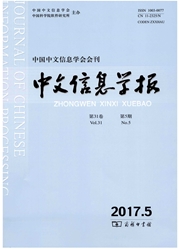

 中文摘要:
中文摘要:
文本表示作为文本分类的一个基本问题,一直广受关注。目前文本表示主要有词袋模型、隐式语义表达和基于知识库的显式语义表达3种方式。本文首先分析对比了这3种文本表示方式在文本分类中的效果。实验发现,基于知识库的显式语义表达并没有如预期一样提高文本分类的效果。经分析,其原因在于显式语义表达在扩展文档表达时易引入噪声。针对该问题,本文提出了一种有监督的显式语义表达方法。该方法利用数据集的标注信息识别文档中与分类最相关的核心概念,并扩展核心概念以形成文档显式语义表达。3个标准分类数据集上的结果证实了本文所提文本表示方法的有效性。
 英文摘要:
英文摘要:
As a fundamental problem of text categorization, text representation is widely concerned. Cur-rently, there are three main ways of text representation: bag-of-words model, latent semantic represen- tation and knowledge-based explicit semantic representation. The paper analyzes and compared the effects of these methods applied to text categorization. Experiments show that the knowledge-based ex- plicit semantic representation cannot improve the text categorization performance as expected. To tackle the problem that the knowledge-based explicit semantic representation easily introduces noise in extending text, a supervised explicit semantic representation method is proposed. The dataset label information is used to identify the most relevant concepts in document and the document is represented in explicit se- mantic based on expanding those key concepts. The results of three datasets confirm the effectiveness of the proposed method.
 同期刊论文项目
同期刊论文项目
 同项目期刊论文
同项目期刊论文
 期刊信息
期刊信息
